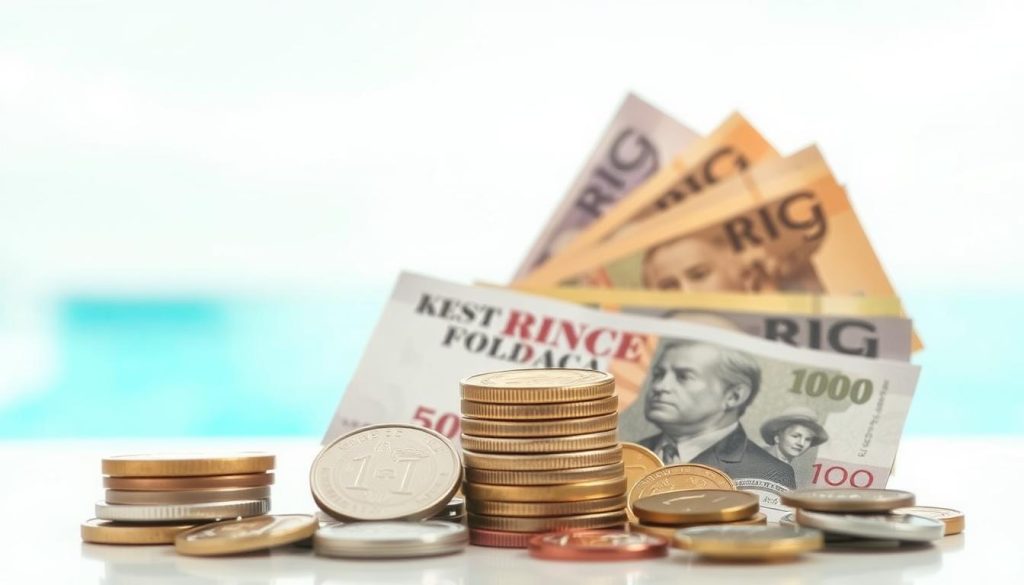✓ Accommodations ✓ Flights ✓ Rental Cars ✓ Tours & Activities
Did you know that the Cook Islands is the world’s second-largest producer of black pearls? While this tropical paradise is famous for its stunning landscapes and unique culture, managing your finances here requires a bit of planning. Understanding the local currency system can save you time and money during your trip.
This guide is designed to help you navigate the ins and outs of handling money in this beautiful destination. From using the New Zealand dollar to avoiding unnecessary fees, we’ll cover everything you need to know. Whether you prefer cash or cards, you’ll find practical tips to make your trip smoother.
For example, tools like the Wise New Zealand dollar travel money card can help you save on conversion rates and fees. By the end of this guide, you’ll feel confident managing your finances while exploring the Cook Islands.
Introduction to Cook Islands and its Currency Landscape
Nestled in the South Pacific, this destination offers breathtaking landscapes and a unique cultural experience. The Cook Islands, a self-governing territory in free association with New Zealand, is a tropical paradise known for its turquoise lagoons, lush mountains, and warm hospitality. Its remote location makes it a perfect escape for those seeking adventure or relaxation.
One of the most convenient aspects of visiting this island nation is its currency system. The official currency here is the New Zealand dollar, which simplifies financial planning for many travelers. This shared currency eliminates the need for complex conversions and ensures a seamless experience when managing your expenses.
Understanding the currency landscape is essential for a stress-free trip. While the New Zealand dollar is widely accepted, it’s important to be aware of local nuances. For example, smaller businesses and remote areas may prefer cash over cards. Being prepared can save you from unexpected challenges during your travel.
Using a familiar currency also helps alleviate common travel concerns. You won’t need to worry about fluctuating exchange rates or hidden fees, allowing you to focus on enjoying your trip. Below is a quick overview of the currency system:
| Aspect | Details |
|---|---|
| Official Currency | New Zealand Dollar (NZD) |
| Cash Preference | Common in remote areas and small businesses |
| Card Acceptance | Widespread in major towns and tourist spots |
As you plan your trip, keep these insights in mind. The following sections will delve deeper into currency differences, financial safety tips, and practical advice to make your journey smoother.
Understanding the Official Currency in the Cook Islands
Managing your finances in this tropical paradise is easier than you might think. The official currency here is the New Zealand dollar, which is widely accepted and simplifies transactions. However, the Cook Islands also issues its own unique banknotes and coins, adding a local touch to your spending experience.
New Zealand Dollar vs. Cook Islands Dollar
While both currencies are used locally, the New Zealand dollar is the primary unit displayed in prices. The Cook Islands dollar is pegged at a 1:1 ratio with the New Zealand dollar, meaning they hold the same value. This makes it easy to use either currency interchangeably.
However, Cook Islands banknotes and coins are only valid within the country. So, if you’re planning to travel elsewhere, it’s best to stick with New Zealand dollars. This ensures you won’t face any issues when converting or spending your money abroad.
Denominations and Coinage Overview
The Cook Islands offers a variety of banknotes and coins that reflect its rich culture. Banknotes come in denominations of $3, $10, $20, and $50, featuring vibrant designs of local landmarks and traditions. Coins include 10, 20, and 50 cents, as well as $1 and $2 pieces.
New Zealand banknotes, on the other hand, are available in $5, $10, $20, $50, and $100 denominations. Their coins range from 10 cents to $2. When handling cash, it’s helpful to familiarize yourself with these denominations to avoid confusion during transactions.
In combined transactions, both currencies are accepted at face value. For example, if you pay with a mix of New Zealand and Cook Islands dollars, the total amount will be calculated based on their equal worth. This flexibility makes it convenient for travelers to use whatever cash they have on hand.
Cook Islands: Ultimate Travelers Guide to Currencies & Payments
Understanding exchange rates can make or break your travel budget. The mid-market rate is the real exchange rate banks use when trading currencies. It’s the fairest rate you can get, but many traditional currency exchange desks add markups, costing you more.

Using tools like the Wise travel money card helps you access the mid-market rate without extra fees. This ensures you get the best value for your money. Traditional exchange desks often apply hidden charges, so it’s essential to compare rates before making a transaction.
Real-time conversion tools are another great way to monitor the exchange rate during your trip. These tools help you stay informed and avoid overpaying. By understanding how rates work, you can save significantly on currency exchange costs.
Here’s a quick tip: Always check the mid-market rate before exchanging money. This simple step can help you avoid unnecessary fees and keep your travel budget intact. With the right knowledge and tools, managing your finances becomes much easier.
Essential Money Tips for Travelers
Handling money wisely during your trip can save you from unnecessary stress and extra costs. With a few smart strategies, you can avoid common financial pitfalls and make the most of your budget. Here’s how to stay on top of your expenses while exploring new destinations.
Avoiding ATM and Transaction Fees
ATMs are convenient, but they often come with hidden fees. To minimize these costs, look for banks that partner with your home bank to waive withdrawal fees. Another tip is to withdraw larger amounts less frequently, reducing the number of transactions and associated fees.
When using your card abroad, always choose to be charged in the local currency. This ensures you get the best exchange rate and avoid additional conversion fees. Prepaid travel money cards, like the Wise card, are also a great way to limit extra costs and manage your budget effectively.
Spotting Hidden Charges and Markups
Hidden charges can sneak into your expenses if you’re not careful. Hotels and currency exchange counters often add markups to their rates. Always compare prices and ask about additional fees before making a transaction.
Another common scenario is dynamic currency conversion, where merchants offer to charge you in your home currency. While it may seem convenient, this option usually comes with a higher cost. Stick to the local currency to secure the best rate.
By staying vigilant and planning ahead, you can avoid these hidden charges and keep your travel budget intact. A little preparation goes a long way in ensuring a smooth and stress-free trip.
Using Cash in the Cook Islands
Having cash on hand is essential for a smooth experience in this tropical destination. While cards are widely accepted in major areas, smaller businesses and remote locations often prefer cash. Planning ahead ensures you’re prepared for any situation.
Where to Get Currency Before and After Arrival
Before your trip, you can exchange your local currency for the New Zealand dollar at banks or currency exchange service centers in your home country. This ensures you have cash ready upon arrival. Many airports also offer currency exchange desks, though rates may vary.
Once you arrive, ATMs are available at major transit points like Rarotonga and Aitutaki. These machines dispense the New Zealand dollar, making it easy to withdraw cash as needed. However, ATMs are limited outside these areas, so plan accordingly.
Local Market Options and Exchange Practices
Local markets can be a convenient place to exchange money, especially if you’re looking for smaller denominations. Always use official service centers to avoid scams. Check that the currency display shows the correct code (NZD) to ensure legitimacy.
Here’s a quick overview of currency dispensing options:
| Option | Details |
|---|---|
| ATMs | Available in Rarotonga and Aitutaki; dispense New Zealand dollar |
| Local Markets | Exchange options available; verify legitimacy |
| Airport Desks | Convenient but rates may vary |
By carefully planning your cash needs, you can enjoy a hassle-free trip. Having the right amount of the New Zealand dollar ensures you’re ready for any adventure, whether exploring bustling markets or remote beaches.
Using Debit and Credit Cards in the Cook Islands
Using debit and credit cards in this tropical destination is convenient, but knowing where and how to use them is key. Major cards like Visa and Mastercard are widely accepted in hotels, restaurants, and retail outlets. However, smaller establishments and local markets often prefer cash, so it’s wise to carry some with you.

Card Acceptance in Major Outlets
In larger towns like Rarotonga, you’ll find that most businesses accept credit cards and debit cards. This includes popular tourist spots, upscale dining venues, and well-known retail stores. Always confirm card acceptance in advance to avoid surprises during your trip.
Here’s a quick breakdown of where cards are commonly accepted:
| Establishment Type | Card Acceptance |
|---|---|
| Hotels | Wide acceptance of Visa and Mastercard |
| Restaurants | Most accept cards; some may charge a small fee |
| Retail Stores | Major outlets accept cards; smaller shops may not |
While cards are convenient, some local vendors and markets may not accept them. Having cash as a backup ensures you’re prepared for any situation. Additionally, international cards may incur transaction fees, so check with your bank before traveling.
By understanding where and when to use your cards, you can enjoy a seamless financial experience. Planning ahead and carrying a mix of payment options will make your trip smoother and more enjoyable.
Wise Travel Money Card and Its Benefits
Traveling internationally? The Wise travel money card is a game-changer for managing your finances abroad. Designed for active travelers, this card lets you top up in your home currency and convert funds in real time. No hidden fees, no surprises—just transparency and convenience.
With the Wise app, you can monitor exchange rates and convert currencies instantly. This ensures you always get the best rate available. Unlike traditional banks, Wise uses the mid-market exchange rate, which is the fairest rate you can find. This means no markups or extra costs, saving you money on every transaction.
Real-Time Currency Conversion
The Wise app makes it easy to convert currencies on the go. Whether you’re paying for a meal or withdrawing cash, you’ll see the exact amount in your local currency. This real-time feature eliminates guesswork and helps you stay within budget.
Mid-Market Exchange Rate Advantages
One of the biggest perks of the Wise card is its access to the mid-market rate. This rate is what banks use when trading currencies, but most travelers never see it. With Wise, you get the same rate without any hidden fees. This can save you significantly on international transactions.
Another benefit is the flexibility of holding multiple currencies on one card. Whether you’re spending in the New Zealand dollar (NZD) or another currency, you can switch seamlessly. This makes it perfect for multi-country trips or frequent travelers.
“The Wise card has completely changed how I manage money abroad. No more worrying about exchange rates or hidden fees.”
By simplifying budgeting and saving you money, the Wise travel money card is a must-have for anyone traveling internationally. It’s the smart way to handle your finances while exploring the world.
ATM Availability and Best Practices
Navigating ATM access during your trip can make your experience smoother and stress-free. In Rarotonga and Aitutaki, ATMs are primarily located in major towns and tourist hubs. Rarotonga, the main island, has several ATMs near banks, shopping centers, and the airport. Aitutaki, while smaller, also offers ATMs in key areas like the main village and popular resorts.
When using ATMs, always select the local currency (New Zealand dollar) to avoid dynamic currency conversion fees. These fees can add up quickly, so sticking to the local option ensures you get the best rate. Additionally, check with your bank about international withdrawal fees before your trip to avoid surprises.
It’s also a good idea to check ATM operating times and network reliability. Some machines may have limited hours or occasional downtime, especially in remote areas. Planning your withdrawals during business hours ensures you’ll have access to cash when you need it.
To guard against fraud, monitor your ATM transactions in real time. Many banks offer mobile apps that send instant notifications for every withdrawal. This helps you spot any unauthorized activity immediately and take action to protect your funds.
Finally, identify multiple ATM options during your trip for financial security. Having a backup plan ensures you’re never left without access to cash, even if one machine is out of service. By following these best practices, you can make the most of your trip without worrying about financial hiccups.
Avoiding Hidden Fees and Getting the Best Exchange Rate
Understanding how to avoid hidden fees can make your trip more enjoyable. When traveling, small charges can add up quickly, inflating your overall expenses. By focusing on the mid-market rate and planning ahead, you can save money and reduce stress.

Understanding the Mid-Market Rate
The mid-market rate is the real exchange rate banks use when trading currencies. It’s the fairest rate you can get, but many traditional exchange desks add markups. These hidden fees can cost you more than you realize.
Using tools like the Wise travel money card gives you access to this rate without extra charges. This ensures you get the best value for your money. Always compare rates before making a transaction to avoid unnecessary costs.
Tips to Prevent Unnecessary Charges
Hidden fees can appear in unexpected places. Hotels and airports often have higher exchange rates. Instead, use established financial businesses for transparent rates. Online currency converters can also help you monitor the exchange rate in real time.
Here are some actionable tips to avoid extra charges:
- Always choose to be charged in the local currency to avoid dynamic currency conversion fees.
- Withdraw larger amounts less frequently to minimize ATM fees.
- Use apps like Wise to track rates and convert currencies instantly.
Planning your currency exchange strategy before and during your trip is key. By staying informed and using the right tools, you can keep your budget intact and focus on enjoying your journey.
| Option | Benefit |
|---|---|
| Mid-Market Rate | Fairest exchange rate with no markups |
| Wise Travel Card | Real-time conversions and low fees |
| Local Currency | Avoids dynamic currency conversion charges |
“Using the mid-market rate saved me hundreds on my last trip. It’s a game-changer for international travel.”
Managing Cash on Hand in Rarotonga and Aitutaki
Planning your cash strategy in Rarotonga and Aitutaki ensures a hassle-free trip. While cards are widely accepted, having local currency on hand is essential for smaller businesses and remote areas. Here’s how to manage your cash effectively during your stay.
Local ATM Usage and Cash Withdrawal Tips
ATMs are available in Rarotonga and Aitutaki, primarily in major towns and tourist hubs. In Rarotonga, you’ll find several ATMs near banks, shopping centers, and the airport. Aitutaki has two ATMs—one at the airport and another in Arutanga. These machines dispense the New Zealand dollar, making it easy to access cash.
When using ATMs, always select the local currency to avoid dynamic currency conversion fees. These fees can add up quickly, so sticking to the local option ensures you get the best rate. Additionally, check with your bank about international withdrawal fees before your trip to avoid surprises.
Here are some tips for safe and efficient cash withdrawals:
- Withdraw larger amounts less frequently to minimize transaction fees.
- Verify if your bank has affiliations with local banks to reduce fees.
- Monitor your transactions in real time using your bank’s mobile app.
It’s also a good idea to check ATM operating times and network reliability. Some machines may have limited hours or occasional downtime, especially in remote areas. Planning your withdrawals during business hours ensures you’ll have access to cash when you need it.
Finally, identify multiple ATM options during your trip for financial security. Having a backup plan ensures you’re never left without access to cash, even if one machine is out of service. By following these best practices, you can make the most of your trip without worrying about financial hiccups.
Safety Tips for Handling Money While Traveling
Staying safe with your money while traveling is just as important as planning your itinerary. Financial security ensures a stress-free trip, allowing you to focus on enjoying your destination. Here are practical tips to keep your valuables secure and your finances protected.
Keeping Your Valuables Secure
One of the simplest ways to protect your money is by safeguarding your PIN code. Never write it down or share it with anyone. Use your hand or body to shield the keypad when entering your code at ATMs or payment terminals.
Using secure apps to monitor your account transactions is another effective strategy. Many banks offer mobile apps that send real-time alerts for every transaction. This helps you spot unauthorized activity immediately.
Minimizing Theft Risks
To reduce the risk of theft, avoid carrying excessive cash. Instead, use a mix of cards and small amounts of local currency. Store larger bills in a hotel safe or hidden compartment in your luggage.
Here’s a quick guide to managing your valuables:
| Tip | Benefit |
|---|---|
| Use a hotel safe | Keeps valuables secure while you’re out |
| Divide money and cards | Reduces loss if one wallet is stolen |
| Use internal pockets | Makes valuables less accessible to thieves |
Maintaining financial security is a key ingredient to a stress-free travel experience. By following these tips, you can save money and enjoy your trip without worrying about financial hiccups.
Business and Personal Currency Transfers
Transferring money internationally doesn’t have to be complicated. Whether you’re sending funds for business or personal reasons, the process can be smooth and cost-effective with the right tools. From secure facilities to online platforms, there are plenty of options to ensure your money reaches its destination safely.
Sending Money to the Cook Island
When sending money to the Cook Island, it’s important to choose a reliable method. Traditional banks often charge high fees and take longer to process transactions. Instead, consider using online transfer services that offer competitive rates and faster delivery. These platforms allow you to manage transfers from the comfort of your home, saving you time and effort.
Here’s a quick guide to sending money efficiently:
- Compare fees and exchange rates across different platforms.
- Use secure facilities that guarantee the safety of your funds.
- Opt for services that provide real-time tracking and notifications.
Online Currency Conversion Tools
Online currency conversion tools are a game-changer for international transfers. These tools allow you to convert funds instantly at the mid-market rate, avoiding hidden fees. Platforms like Wise and Revolut are popular choices for their transparency and ease of use. They also let you hold multiple currencies, making it easier to manage your finances.
Here’s why online tools are a smart choice:
- They offer real-time exchange rates, ensuring you get the best value.
- You can track transactions and manage your account from the comfort of your home.
- They often have lower fees compared to traditional banks.
By leveraging these tools, you can make your international transfers quick, secure, and cost-effective. Whether you’re sending money for business or personal reasons, these solutions ensure a smooth experience.
Avoiding Currency Pitfalls at Hotels and Airports
Currency exchange desks at hotels and airports often come with hidden costs. These transit points are convenient but can be expensive due to higher fees and unfavorable exchange rates. Understanding why this happens and how to avoid it can save you money and stress during your trip.
Why Exchange Rates Can Vary at Transit Points
Hotels and airports typically charge higher fees for currency exchange because they cater to travelers who need quick access to cash. These facilities often add markups of 5% to 15% to the mid-market rate, making their rates less favorable. For example, while the mid-market rate might be 1 USD = 0.92 EUR, a hotel or airport desk could offer 1 USD = 0.85 EUR.
Additionally, these locations may include hidden fees in their transactions. These fees can include service charges, processing fees, or even dynamic currency conversion costs. These extra charges can quickly add up, especially if you’re exchanging large amounts of money.
How to Avoid These Pitfalls
Planning ahead is the best way to avoid high fees at hotels and airports. Here are some actionable tips:
- Exchange your currency before your trip at a local bank or reputable online service.
- Use ATMs outside of the airport or hotel areas to access better rates.
- Carry a mix of cash and cards to avoid relying solely on currency exchange desks.
Researching local exchange options in advance can also help. Many cities have reputable exchange services in the downtown area or near major tourist spots. These services often offer better rates and lower fees compared to transit points.
Alternative Exchange Services
Instead of using hotel or airport desks, consider these alternatives:
| Option | Benefit |
|---|---|
| Local Banks | Offer competitive rates and lower fees |
| Online Platforms | Provide real-time mid-market rates |
| ATMs | Access local currency at fair rates |
By preparing your currency needs in advance and using these alternatives, you can avoid unnecessary costs and enjoy a smoother travel experience. A little planning goes a long way in ensuring you get the best value for your money.
Leveraging Cards and Cash for a Smooth Trip
Balancing cash and card payments can make your travel experience seamless and stress-free. Knowing when to use each method ensures you’re prepared for any situation. This flexibility is especially useful in destinations where payment preferences vary.
For local activities or small vendor purchases, cash is often the preferred option. Many markets, street vendors, and smaller establishments may not accept cards. Carrying cash ensures you won’t miss out on unique experiences or souvenirs.
On the other hand, cards are ideal for larger expenses like restaurant bills or hotel payments. Major establishments typically accept Visa and Mastercard, making transactions quick and secure. Using cards also helps you track your spending more easily.
Relying exclusively on one payment method can lead to challenges. For example, using only cards might leave you stranded in areas with limited card acceptance. Similarly, carrying too much cash can be risky. A balanced approach is key.
Here’s a quick guide to when to use cash or cards:
| Scenario | Preferred Payment Method |
|---|---|
| Local markets or small vendors | Cash |
| Restaurants or hotels | Card |
| Transportation or tours | Mix of cash and card |
By blending cash and cards, you can enjoy a smoother trip. This strategy not only enhances convenience but also ensures you’re ready for any activity or expense. Flexibility in payment methods is a simple yet effective way to elevate your travel experience.
Keeping Track of Your Expenditures
Staying on top of your spending while traveling ensures you can focus on enjoying your trip. Effective budgeting and expense monitoring are essential for avoiding financial surprises and making the most of your journey. Here’s how to manage your money wisely and keep your travel budget intact.
Budgeting and Expense Monitoring Tips
Start by setting a daily spending limit. This helps you allocate funds for activities, meals, and souvenirs without overspending. Use a simple notebook or a budgeting app to track every transaction. Writing down your expenses keeps you accountable and aware of where your money goes.
Monitoring exchange rates is another key step. Use online tools like Wise or XE Currency Converter to calculate costs in real time. These apps provide accurate conversions, helping you understand the true cost of purchases in your home currency.
![]()
- Divide your funds into categories like accommodation, food, and entertainment.
- Use a prepaid travel card to limit overspending and avoid foreign transaction fees.
- Check your bank statements regularly to spot any unauthorized charges.
Effective budgeting not only saves money but also reduces stress. For example, knowing the average cost of a flight or accommodation in advance helps you plan better. Research shows that travelers who track their expenses tend to have more enjoyable trips.
“Budgeting isn’t about restricting yourself—it’s about making smart choices to enhance your travel experience.”
By staying aware of your spending, you can avoid surprises and keep your travel expenses manageable. Whether you’re exploring the world or relaxing on a beach, smart money management ensures a smoother and more enjoyable journey.
Conclusion
Planning your finances before a trip can make all the difference in your experience. This guide has covered essential tips like understanding currency options, using cards wisely, and mastering ATM practices. By staying informed, you can avoid unnecessary fees and make your journey smoother.
Careful financial planning ensures you’re ready for any situation. Whether it’s carrying cash for local markets or using cards for larger expenses, these strategies help you stay in control. Every year, travelers who plan ahead enjoy more predictable and stress-free trips.
Implementing these tips can save you money and time. From monitoring exchange rates to avoiding hidden charges, small steps add up. Staying vigilant about your finances allows you to focus on enjoying your destination fully.
As you prepare for your next adventure, remember that a little preparation goes a long way. With the right approach, you can turn every year’s trip into a better financial experience. Enjoy your travels while keeping your budget intact!
The above is subject to change.
Check back often to TRAVEL.COM for the latest travel tips and deals.
Here are some Tours & Sightseeing suggestions that might pique your interests!





